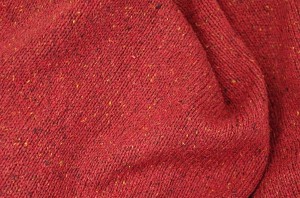30
2013Taste for good materials
I have a passion for good materials and a profound dislike of rubbish. Every object around you has been produced. Before you can produce something the raw material has to be dug up first. Subsequently the raw material has to be flown in somewhere in some factory. The factory will surely blow a lot of smog in the air and expel its cooling water in some river. That’s all acceptable if you get a high quality product in the end, which you want to use for a very long time and with pleasure. You will grow attached to it when it does what it has to do and never lets you down, when its surface feels good and its looks are attractive.
Wool. For example, a pullover that you bought for winter should keep you warm, not only this year but for years to come. You will like it not only for its looks but for its comfort and durability as well. High quality pure woolen yarns are quite appropriate to make such a pullover. Woolen fibres:
- are highly isolating;
- stay in form;
- can absorb humidity for more than half of its own weight without feeling moist;
- are self-cleaning and do not absorb odours;
- are self extinguishing.
And there are so many different kinds of wool: Hair from yak (Mongolia), alpaca (Peru), cashmere goat (India), and camel (Central Asia). Hair from various European sheep breeds like merino and drenthe heath sheep. And of course the Hair of the Lambs! And the best part is you don’t even have to kill them, just a shave every now and then will do!
Did you by the way know that wool called mohair is from the angora goat and that wool called angora is from the angora rabbit?
So far for the benefits. Now for the disadvantages: wool is hair and hair has scales. Erect scales easily interweave. That is how you can make felt. The process of felting is stimulated by rubbing, heat and soap. The felting process also makes wool shrink. If you don’t want this to happen, simply use cold water and a woolmark detergent in combination with the wool programme on your washing machine. Usually it is sufficient to wash your woolen garments only once per season. Simply hang it out to give it some fresh air after you’ve worn it. Superwash qualities are treated against felting.
Some people are allergic to wool or find it prickly. Depending on the extent of your reaction you should not wear pure wool directly on the skin. However, you might give alpaca a try. It does not contain lanolin which generally is the cause of the irritation.
Also be aware of the moth! It loves wool, just like you do.
(Partial) synthetic yarns. Many fashionable bulky yarns contain a good deal of synthetic fibres, which I personally don’t like. A piece of garment made out of such a yarn looks attractive, certainly, but when it has been worn a few times it often starts to show those little pellets and you’ll never stop plucking them off anymore.
Besides that, it will absorb perspiration odours and you won’t be able to wash them out easily. I always have the feeling of getting sweaty much faster when wearing something synthetic. But I am not sure if this is merely my perception because I expect to get sweaty or that it is based on a fact.
Sometimes however, it is necessary to put a thin but strong synthetic filament in a fragile woolen yarn to make it stronger and that’s ok. You don’t want your yarn to break while knitting.
Silk. I love silk for its magnificent features. It is so soft to the skin, so luxurious and delicate! You really feel treated by nature when wearing silk. And silken fabric looks so beautiful: the subtle sheen, the supple way it follows the body curves. And its capability of regulating temperature is also worth to be mentioned: in winter it is warming en in summer it feels cool and refreshing.
Since all animal fibres are on the menu of the moth you have to store your silken luxuries in a safe place. Also handle silk with care, it is fragile.
Unfortunately silk is associated with a weak spot: the silk industry. It is comparable to keeping animals for their fur. It is brutal and harsh to the silk worm. Therefore I preferably use organic silk, also known as bourette silk. The main difference is that it isn’t spun from the long filaments coming from the cocoon but from the shorter leftover fibres. It still is very beautiful though and it has all the positive features, but for the sheen.
I plan to work with linen and organic cotton too, just follow my blogs to learn more about my future projects.

